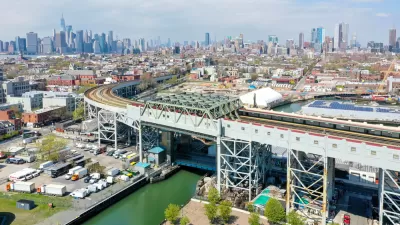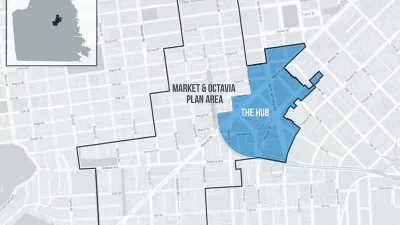Vast amounts of tech money have transformed the city's commercial spaces in unexpected ways.

Adrian Daub takes a closer look at the area around Church and Market streets in San Francisco to better understand the phenomenon of commercial spaces remaining empty after businesses have been priced out:
[Sparky’s diner] was first to go: in 2015 rent suddenly went up, the diner’s owner refused to pay, and Sparky’s was no more. Our usual ideas about gentrification suggest neighborhood standbys get replaced by fancy boutiques and brunch-centric eateries. Instead, after Sparky’s came … nothing. Elsewhere, too, long-term leases timed out, rents increased, and the old neighborhood hangouts disappeared.
The area has seen huge growth in the number of residents and upscale residential developments, but storefronts remain unoccupied, says Daub. "Developers make their money with luxury apartments aimed at high-salaried tech workers, while ground floor retail is an architectural and economic afterthought: giant spaces that any business would have trouble filling with life and justifying financially."
Daub points to California’s Proposition 13 and the cap on property taxes as a factor in this market dynamic. "Owners may pay Nixon-era property tax rates, while renting out those spaces at rates that have exploded in the last 40 years. They, too, can afford to let buildings sit empty."
San Francisco highlights the link between the technology industry and capitalism and the change that ingenuity and money can bring, says Daub. "But walk through parts of San Francisco today, and you get a different sense altogether: not an uncanny effectiveness, but a panicked swirl of homeless capital."
FULL STORY: Abandoned stores, empty homes: why San Francisco's economic boom looks like a crisis

Alabama: Trump Terminates Settlements for Black Communities Harmed By Raw Sewage
Trump deemed the landmark civil rights agreement “illegal DEI and environmental justice policy.”

Planetizen Federal Action Tracker
A weekly monitor of how Trump’s orders and actions are impacting planners and planning in America.

The 120 Year Old Tiny Home Villages That Sheltered San Francisco’s Earthquake Refugees
More than a century ago, San Francisco mobilized to house thousands of residents displaced by the 1906 earthquake. Could their strategy offer a model for the present?

In Both Crashes and Crime, Public Transportation is Far Safer than Driving
Contrary to popular assumptions, public transportation has far lower crash and crime rates than automobile travel. For safer communities, improve and encourage transit travel.

Report: Zoning Reforms Should Complement Nashville’s Ambitious Transit Plan
Without reform, restrictive zoning codes will limit the impact of the city’s planned transit expansion and could exclude some of the residents who depend on transit the most.

Judge Orders Release of Frozen IRA, IIJA Funding
The decision is a victory for environmental groups who charged that freezing funds for critical infrastructure and disaster response programs caused “real and irreparable harm” to communities.
Urban Design for Planners 1: Software Tools
This six-course series explores essential urban design concepts using open source software and equips planners with the tools they need to participate fully in the urban design process.
Planning for Universal Design
Learn the tools for implementing Universal Design in planning regulations.
Clanton & Associates, Inc.
Jessamine County Fiscal Court
Institute for Housing and Urban Development Studies (IHS)
City of Grandview
Harvard GSD Executive Education
Toledo-Lucas County Plan Commissions
Salt Lake City
NYU Wagner Graduate School of Public Service





























